Oahu Scuba- Oahu Scuba Diving Hawaii ! Dive Oahu Honolulu, discover scuba with us, shipwreck scuba diving, Hawaii scuba, beginner diving, first time scuba diving Oahu advanced, certification courses and referrals. Scuba dive in Oahu - Waikiki Honolulu Diving ! Going diving just got easier !


Dive Dangers in Oahu- Scuba Diving Hawaii
Dangerous marine life of Hawaii when scuba diving in Oahu. Although your chances of getting hurt scuba diving in Hawaii are extremely remote we decided to give you, the first time scuba diver in Oahu some valuable information on what you can look out for while diving in Oahu. As you all know Hawaii scuba diving can have some dangers. Here we listed some of the regularly seen marine animals of Hawaii that you may encounter. This is not meant to scare or dissuade you from participating in Hawaii scuba diving but more of an educational awareness of what is in our beautiful oceans here while diving in Hawaii. In reality you are more likely to get into a car accident in Waikiki than to be hurt by one of these marine animals listed below. We just thought that diving in Oahu, people need to be aware of potential problems they may face while scuba diving in Hawaii.
Now, of course Oahu Diving is not a medical center or injury consultants. Therefore, if you do have any issues with any of the marine life listed below, seek medical attention right away.
Oahu Scuba Diving Dangers
The information contained on this page can be disputed however this is just friendly information. To get a better understanding but by all means search on the internet for back up information as well. Running an Internet search on a specific animal will give you a broader idea on the animal in question.
Sharks in Hawaii - Reef sharks of Oahu
Sharks are very common in Hawaii. Seeing a shark while scuba diving in Oahu
is a thrill of a lifetime.
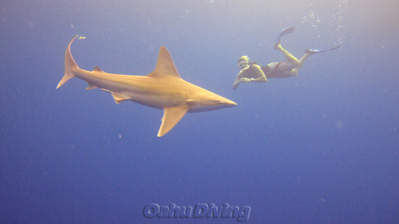 Sharks are usually very docile, slightly
curious however they tend to stay away from scuba divers in Hawaii.
Snorkelers and
swimmers on the other hand should use caution when at the surface.
People floating on the surface do resemble turtles which are a
favorite meal for tiger sharks.
Sharks are usually very docile, slightly
curious however they tend to stay away from scuba divers in Hawaii.
Snorkelers and
swimmers on the other hand should use caution when at the surface.
People floating on the surface do resemble turtles which are a
favorite meal for tiger sharks.
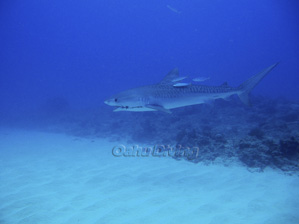 Hawaii and Oahu do get shark attacks
in this situation. While scuba diving in Hawaii divers seldom get attacked unless provoking or spearing fish.
Spear fishermen in Hawaii have a bad habit of strapping the speared
fish to their belts while spearing. It's said that swimming, surfing
or snorkeling at dusk or dawn is dangerous since this is
the time sharks in Hawaii are
more active.
Hawaii and Oahu do get shark attacks
in this situation. While scuba diving in Hawaii divers seldom get attacked unless provoking or spearing fish.
Spear fishermen in Hawaii have a bad habit of strapping the speared
fish to their belts while spearing. It's said that swimming, surfing
or snorkeling at dusk or dawn is dangerous since this is
the time sharks in Hawaii are
more active.
Unicorn Fish of Oahu
 Surgeon fish are the quintessential reef fish on all reefs of the
world. The fish pictured is called orangespine unicorn fish. Most people don't see these fish as being a potential
problem. The problem with surgeon fish is what is attached to the
rear dorsal fin. A razor sharp fin that is used for defensive
purposes. The knife like scalpel is located inside where the star is
marked. The picture you see is a photo taken on a
Hawaii night scuba dive. These fish
wedge themselves into little crevices and sleep. Night time
predators like the eels will think twice before trying wrestle the
surgeon fish out. People who fish or spearfish the surgeon fish need
to really pay close attention so as to not touch the rear tail area.
Typical scenario who be divers reaching in the hole, grabbing the
tail and trying to pull the fish out. These fish vibrate their tail
at a high rate that will cause immediate injury to your hand even
with gloves on. Best to just take pictures.
Surgeon fish are the quintessential reef fish on all reefs of the
world. The fish pictured is called orangespine unicorn fish. Most people don't see these fish as being a potential
problem. The problem with surgeon fish is what is attached to the
rear dorsal fin. A razor sharp fin that is used for defensive
purposes. The knife like scalpel is located inside where the star is
marked. The picture you see is a photo taken on a
Hawaii night scuba dive. These fish
wedge themselves into little crevices and sleep. Night time
predators like the eels will think twice before trying wrestle the
surgeon fish out. People who fish or spearfish the surgeon fish need
to really pay close attention so as to not touch the rear tail area.
Typical scenario who be divers reaching in the hole, grabbing the
tail and trying to pull the fish out. These fish vibrate their tail
at a high rate that will cause immediate injury to your hand even
with gloves on. Best to just take pictures.
Crown of Thorns of Oahu
Crown of Thorns starfishes are occasionally spotted on the reefs of Hawaii
and when scuba diving in Waikiki. Theses are beautiful stars, kind of a dark red in color with 8 legs.
These guys if accidentally touched or stepped on, the starfish's long spines which release a
neurotoxin) are capable of stinging, inflicting great pain that
can last for hours, as well as nausea and vomiting.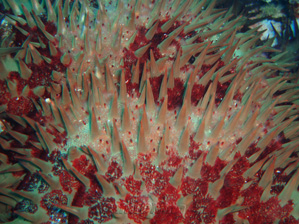 The spine(s) may
be left imbedded in the skin, which in that case must be completely
removed by a doctor. The crown of thorns starfish actually east
coral, leaving a white skeleton of coral behind. Scuba divers in
Hawaii definitely do not like this starfish.
The spine(s) may
be left imbedded in the skin, which in that case must be completely
removed by a doctor. The crown of thorns starfish actually east
coral, leaving a white skeleton of coral behind. Scuba divers in
Hawaii definitely do not like this starfish.
Sea Urchins in Hawaii
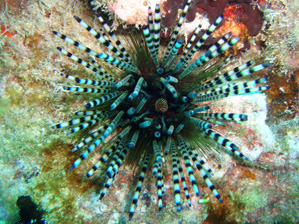 One thing is for sure, you will will see sea urchins in Hawaii and
especially when snorkeling or scuba diving in Oahu. Stay well clear
of sea urchins. Sea urchins in Hawaii look beautiful but their long micro-needle-like
spines can pierce the skin better than a syringe.
One thing is for sure, you will will see sea urchins in Hawaii and
especially when snorkeling or scuba diving in Oahu. Stay well clear
of sea urchins. Sea urchins in Hawaii look beautiful but their long micro-needle-like
spines can pierce the skin better than a syringe.
 Wetsuits, or
clothing for that matter will not do anything to protect you. Proper buoyancy
while scuba diving and care must be taken when around these little menaces.
Sea urchins are an important part of the reef's ecological system.
Most people will get spines in their feet or hands. Although more of
a nuisance you will not most likely have to see a doctor. There
could be some severe causes where this is not the cause.
Wetsuits, or
clothing for that matter will not do anything to protect you. Proper buoyancy
while scuba diving and care must be taken when around these little menaces.
Sea urchins are an important part of the reef's ecological system.
Most people will get spines in their feet or hands. Although more of
a nuisance you will not most likely have to see a doctor. There
could be some severe causes where this is not the cause.
Stingrays in Hawaii
Hawaiian Stingrays are found throughout the Hawaiian island chain.
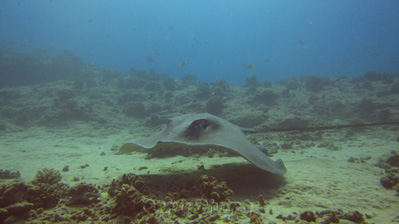 Most scuba divers in
Hawaii will see these magnificent creatures swimming very
majestically on the sea floor searching for small fish and crabs to
feed on. Care must be taken when approaching the
Most scuba divers in
Hawaii will see these magnificent creatures swimming very
majestically on the sea floor searching for small fish and crabs to
feed on. Care must be taken when approaching the
 Hawaiian
stingray. We all know about the "stinger" located on the base of the
tail. Avoid molesting, grabbing or trying to ride a stingray. These
stings can be fatal but must are just very painful. If stung we
recommend seeing a doctor right away.
Hawaiian
stingray. We all know about the "stinger" located on the base of the
tail. Avoid molesting, grabbing or trying to ride a stingray. These
stings can be fatal but must are just very painful. If stung we
recommend seeing a doctor right away.
Eels in Hawaii, Dragon Moray Eels
Eels are very noticeable and the most feared fish on the reef.
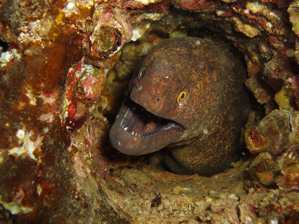 Their TV reputation is-I hate to say fact.
These snake like looking fish strike
lightening fast with fang-like teeth that slice like a razor.
Their TV reputation is-I hate to say fact.
These snake like looking fish strike
lightening fast with fang-like teeth that slice like a razor.
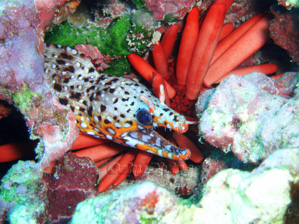 Their
prey can not escape due to the inward directions of the teeth. Eel
bites can be very serious often causing major tendon and muscle
damage. Scuba diving in Hawaii you will see many kinds of eels, such
as the dragon moray eel, yellow margin moray and the white mouth
moray.
Their
prey can not escape due to the inward directions of the teeth. Eel
bites can be very serious often causing major tendon and muscle
damage. Scuba diving in Hawaii you will see many kinds of eels, such
as the dragon moray eel, yellow margin moray and the white mouth
moray. 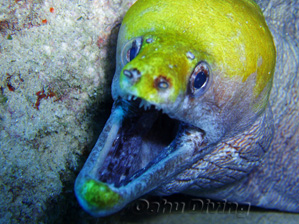 We always warn divers to be cautious, not to provoke or
place hands close to these fish. Eels do not have good eye site relying
on their sense of smell for zeroing in on food. Eels do almost eat
everything including wounded fish, crabs and handouts from divers. (which we do not
recommend) There are numerous types of eels and some are more dangerous than others.
A good rule a thumb- Don't mess with any of the eels. Eels will ruin your day for sure.
We always warn divers to be cautious, not to provoke or
place hands close to these fish. Eels do not have good eye site relying
on their sense of smell for zeroing in on food. Eels do almost eat
everything including wounded fish, crabs and handouts from divers. (which we do not
recommend) There are numerous types of eels and some are more dangerous than others.
A good rule a thumb- Don't mess with any of the eels. Eels will ruin your day for sure.
Jellyfish in Oahu, Hawaii - Box Jellyfish in Hawaii
Jellyfish come in all shapes and sizes and pretty much scare the dickens out
of most swimmers and scuba divers alike.
 When Scuba diving in Oahu you rarely
see jellyfish. However there are times in Oahu when jellyfish tend
to be seen. Usually 7-11 days after a full moon cycle. The bad news
are these types of jellyfish are the venomous box
jellyfish.
Most jellyfish stings are nothing to really worry about however some
people can be allergic and have severe reactions. Best to seek
medical attention right away if stung by a box jelly fish or any
type for that matter.
When Scuba diving in Oahu you rarely
see jellyfish. However there are times in Oahu when jellyfish tend
to be seen. Usually 7-11 days after a full moon cycle. The bad news
are these types of jellyfish are the venomous box
jellyfish.
Most jellyfish stings are nothing to really worry about however some
people can be allergic and have severe reactions. Best to seek
medical attention right away if stung by a box jelly fish or any
type for that matter.
Scorpion Fish (Devil Scorpion Fish shown here)
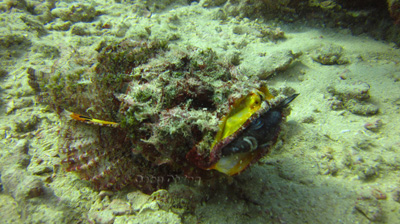 Very commonly seen on Hawaii's reef structure...that is if you can find them.
With their amazing camouflage and their ability to not move when molested makes
these fish the ultimate ambush predator in Hawaii.
Their pectoral fins which are
not really visible have a bright yellow and red color which when disturbed will
be seen. That right there should be enough warning not mess with this reef fish.
Occasionally reef walkers, snorkelers and divers alike can get stung by this
scorpion fish. Although the sting is relatively mild compared to the lionfish it
does hurt and can make a grown man cry.
Very commonly seen on Hawaii's reef structure...that is if you can find them.
With their amazing camouflage and their ability to not move when molested makes
these fish the ultimate ambush predator in Hawaii.
Their pectoral fins which are
not really visible have a bright yellow and red color which when disturbed will
be seen. That right there should be enough warning not mess with this reef fish.
Occasionally reef walkers, snorkelers and divers alike can get stung by this
scorpion fish. Although the sting is relatively mild compared to the lionfish it
does hurt and can make a grown man cry.
Barracuda in Oahu, Hawaii - Barracuda in Hawaii
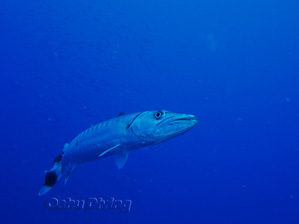 Barracudas with their name that strikes fear in any swimmer or diver is one
of Hawaii's if not the world's most top successful predatorily fish. Finding
these fish are not as easy as other reef fish. They occasionally remain still
over the reef or to the side waiting to lunge like a laser bolt to an
unsuspecting fish. There has been attacks on humans in Hawaii however from the
research we have done those attacks occurred in the 60s and wee the result of
spearfish and collecting fish. Honestly speaking, there is no need to really
worry about this fish however we thought in the interest of their reputation to
put them in our Dangerous Marine Life page.
Barracudas with their name that strikes fear in any swimmer or diver is one
of Hawaii's if not the world's most top successful predatorily fish. Finding
these fish are not as easy as other reef fish. They occasionally remain still
over the reef or to the side waiting to lunge like a laser bolt to an
unsuspecting fish. There has been attacks on humans in Hawaii however from the
research we have done those attacks occurred in the 60s and wee the result of
spearfish and collecting fish. Honestly speaking, there is no need to really
worry about this fish however we thought in the interest of their reputation to
put them in our Dangerous Marine Life page.
Marine life of Hawaii - Fish, Sea Turtles, Octopus and more
- Fish and Reef Fish
- Tiger Sharks
- Moray Eels/Eels
- Monk Seals of Hawaii
- Dolphins in Hawaii
- Octopus
- Humpback Whales in Hawaii
- Hawaiian Green Sea Turtle
- Sting Rays, Eagle Rays and Manta Rays
- Dangerous Marine Life

